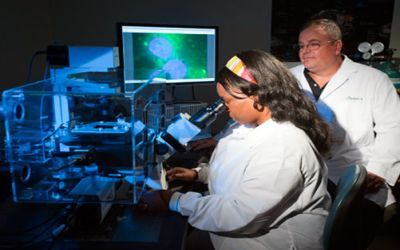Study Suggests Dormant Malaria Parasites in Red Blood Cells May Contribute to Treatment Failure


Alexis LaCrue, PhD, lead author of the study, with principal investigator
Dennis Kyle, PhD.
Researchers at the University of South Florida (USF) College of Public College Health have shown for the first time in a rodent model that the earliest form of malaria parasites can lay dormant in red blood cells and wake up, or recover, following treatment with the antimalarial drug artesunate.
The study, which appears today in the online journal PLoS ONE, suggests that this early-stage dormancy phenomenon contributes to the failure of artesunate alone, or even combined with other drugs, to eliminate the mosquito-borne disease. Alexis LaCrue, PhD, research associate in the USF Department of Global Health, is the lead author of the study, which was funded by the National Institute of Allergy and Infectious Diseases (NIAID).
The emergence of parasites resistant to artesunate therapy along the Thai-Cambodian border could seriously undermine the success of global malaria control efforts, the World Health Organization has reported.
There is an urgent public health need to understand why this antimalarial drug resistance is happening and the basis for it, so we can help arrest its spread, says principal investigator Dennis Kyle, PhD, distinguished university health professor at the USF College of Public Health.
Our study was able to induce the same dormant stage in vivo in a rodent malaria model that was previously seen only in the test tube, Kyle said. The work suggests that dormancy is involved in the earliest stage of parasite development in the red blood cells. It may be a new mechanism for how the parasite avoids being wiped out by artemisinin drugs.
When mice infected with rodent malaria parasites were treated with artesunate, dormant parasites were present in their red blood cells 24 hours following treatment. The researchers also found a positive association between the number of dormant parasites present and when malaria infection re-emerged in the mice.
More studies are needed to help explain the mechanism behind the early-stage dormancy and its contribution to treatment failure.
Now that we have a robust animal model for studying how the parasites become dormant and then recover, Kyle says, we may be able to change our dosing regimens and investigate drug partners for artemisinin that are better at killing the dormant parasites.
Malaria parasites are transmitted by the bite of an infected mosquito. In humans, they enter red blood cells and start replicating after being released from the diseases first target, the liver.  Once parasites escape into the bloodstream, disease symptoms emerge including chills, fever, headache, body aches, vomiting and exhaustion.
Malaria affects 10 percent of the worlds population, killing nearly one million people a year in developing countries and crippling their economies. Most who die or become ill are poor pregnant women and children under age 5 in tropical and subtropical regions of Africa, Asia and South America.
In addition to LaCrue and Kyle, the study authors were Misty Scheel, Katherine Kennedy and Nikesh Kumar all members of the USF Global Infectious Disease Research team.
Â
Our Understanding of Immune Issues Is Evolving: Here Are 5 Reasons Why
October 25th 2024The past 5 years in medicine have seen significant advances in RNA vaccines, understanding immune dysregulation, and improved interspecialty communication, promising better disease eradication and tailored treatments.